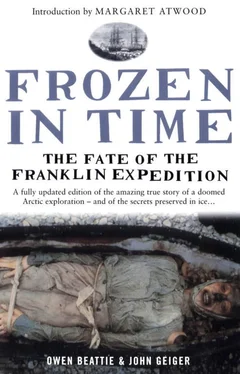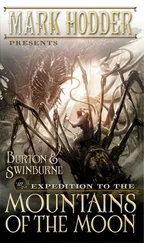Royal Navy officers Captain Francis Crozier and Commander James Fitzjames were also appointed to the expedition. The veteran Crozier had served in a number of earlier attempts at finding both a Northwest Passage and reaching the North Pole and had been second-in-command of James Clark Ross’s Antarctic expeditions as commander of the Terror. As for Fitzjames, he had served as mate aboard the first steamer to successfully navigate the Euphrates, and had served on ships operating in the Middle East and China, where he first became interested in the romantic lure of the Northwest Passage.
Captain Francis Crozier.
The days before the Erebus and Terror set sail were filled with social engagements and a general sense of excitement. The confidence of the expedition team was palpable. In a letter to his brother dated 11 April 1845, Harry D.S. Goodsir, the assistant surgeon on the Erebus, wrote: “All the Officers are in great hopes of making the passage and expect to be in the Pacific end of next summer.” Franklin and his officers were entertained at the Admiralty on 8 May. The crews were paid in advance of the sailing, and it can be assumed that at least some of the money was spent at the pubs dotting the docklands along the Thames. On 9 May, the final official inspection of the ships took place, attended by leading civil and naval figures and other specially invited guests. The Illustrated London News reported that “the arrangements made for the comfort of the officers and crews are excellent. The quantity of stores taken on board is considerable.” According to a Times reporter, those stores included “numerous chests of tea, although the crews are not expected to become teetotalers, an ample supply of rum having been provided for their use in the frozen regions.”
Commander James Fitzjames.
Among the food supplies were nearly 8,000 tins of preserved meats (including boiled and roast beef, boiled and roast mutton, veal, seasoned beef and ox-cheek), vegetables (potatoes, parsnips, carrots and mixed vegetables) and soup (of 1-, 2-, 4-, 6-and 8-pound/.5-, 1-, 2-, 3-, 4-kg capacity). They also carried 1,203 pounds (546 kg) of tinned pemmican. Other supplies included 7,088 pounds (3,218 kg) of tobacco, 200 gallons (909 litres) of “wine for the sick” and 9,450 (4,290 kg) of chocolate. Some 9,300 pounds (4,222 kg) of lemon juice were also taken, to be rationed to all during the expedition.
With such vast quantities of provisions and fuel, enough to last three years, the accommodations were congested. Of the living quarters, only Franklin’s cabin on the Erebus was of any significant size. Commander Fitzjames had a cabin less than 6 ½ feet (2 metres) wide, with the crew of the Erebus berthed in what little space remained (many slung their hammocks alongside one another on the mess deck). Yet despite the cramped quarters, the Erebus had a library of 1,700 volumes, the Terror carried 1,200, including everything from narratives of earlier Arctic expeditions and geographical journals to Charles Dickens’s Nicholas Nickleby and bound copies of Punch magazine. Each ship also had a hand organ that could play fifty tunes, including ten hymns. There were mahogany writing desks for officers and school supplies for teaching illiterate sailors to read and write. Instruments for research in geology, botany and zoology and for magnetic observation were also taken. The Franklin expedition was also one of the first voyages of discovery to carry that relatively new invention: a camera.
Commander Fitzjames’s cabin on the HMS Erebus .
No Arctic expedition had ever been so lavishly outfitted. The same could be said even for the men, who were issued gear for extreme weather, suggesting a greater willingness on the part of British officialdom to adapt and learn from the Inuit than is generally credited. Indeed, Goodsir reported being issued sealskin gloves, a sealskin cap and greatcoat and a pair of “Deer-skin” trousers.
On 5 May, Franklin received his official instructions: essentially to sail to Baffin Bay and Lancaster Sound through to the Bering Strait and, in so doing, complete a Northwest Passage—all the while collecting valuable scientific and geographical information. There were no plans for Admiralty assistance or relief should the expedition encounter difficulty or fail to complete its voyage within the three years it had been supplied for. As a cursory precaution, the Hudson’s Bay Company, with its fur-trading outposts at Fort Good Hope and Fort Resolution in what is now Canada’s Northwest Territories, was asked to aid the expedition should word of trouble be received. The company was also instructed to alert native traders to watch for Franklin’s crews.
In the last few days before he sailed, Franklin may have experienced a premonition of his fate. Suffering from the flu, he was resting at home with his wife, Jane, who had just finished sewing a silk Union Jack for him to take. Concerned about his illness, she draped the flag over his legs for warmth. He sprang to his feet: “There’s a flag thrown over me! Don’t you know that they lay the Union Jack over a corpse?” But on Sunday 18 May, the eve of his departure, with his wife and daughter present, the profoundly religious Franklin read Divine Service for the first time to his crews. And when the expedition sailed from the Thames the next morning, carrying 134 officers and men, most felt the Franklin expedition could not fail. Franklin’s only child, Eleanor, wrote to an aunt:
Just as they were setting sail, a dove settled on one of the masts, and remained there for some time. Every one was pleased with the good omen, and if it be an omen of peace and harmony, I think there is every reason of its being true.
The expedition was already out of view when the Times trumpeted:
There appears to be but one wish amongst the whole of the inhabitants of this country, from the humblest individual to the highest in the realm, that the enterprise in which the officers and crew are about to be engaged may be attended with success, and that the brave seamen employed in the undertaking, may return with honour and health to their native land.
One week later, the president of the Royal Geographical Society, Sir Roderick Murchison, summed up the public mood in a speech: “The name of Franklin alone is, indeed, a national guarantee.” Besides, the geographical obstacles were by now judged to be not all that great: The cumulative discoveries of preceding Arctic expeditions—Parry, John Ross, George Back, and Franklin’s among them—had resulted in the mapping of much of the southern Arctic archipelago. By 1845, stretches of less than 62 miles (100 km) remained to be explored, and it was to close those gaps that Franklin sailed.
After calling briefly at Stromness Harbour on the island of Orkney, the expedition left Britain for the last time. A transport vessel, the Barretto Junior, laden with stores such as ten live oxen, accompanied the ships to the Whalefish Islands in Disco Bay on the west coast of Greenland, where the oxen were slaughtered for fresh meat and supplies transferred to the Erebus and Terror. Harry Goodsir wrote to his uncle from Greenland that, “we have got 10,000 cases of preserved ready cooked meats on board the Erebus alone so you see there is no chance of starving.” It was also while at the Whalefish Islands that the first tins of preserved meat, carrots and potatoes were opened, and the contents served to the expedition’s officers.
Franklin also wrote a letter in which he said his final goodbye to Lady Franklin. It was a message full of optimism:
Let me now assure you, my dearest Jane, that I am amply provided with every requisite for my passage, and that I am entering on my voyage comforted with every hope of God’s merciful guidance and protection, and that He will bless, comfort and protect you, my dearest… and all my other relatives. Oh, how much I wish I could write to each of them to assure them of the happiness I feel in my officers, my crew, and my ship!
Читать дальше










